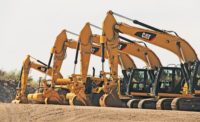
Construction machinery suppliers have posted a robust second quarter fueled by infrastructure and mining activity in Asia and Latin America. Meanwhile, rental companies and contractors in North America have been replacing aging and obsolete fleets for a small but significant uptick in domestic sales revenue.
“Global business demand helped many equipment manufacturers get through the recession,” says Dennis Slater, president of the Association of Equipment Manufacturers, a Milwaukee-based industry trade group. “They still rely on export sales, especially to emerging markets, for improved business results.”
Caterpillar Inc.’s second-quarter earnings soared to $1.02 billion, a 44% increase over last year, but the Peoria, Ill.-based equipment maker still fell short of analyst expectations. Caterpillar stock consequently dropped 13.5% in two weeks following its July 22 earnings announcement; company shares had been up 19% on the year. Caterpillar blamed U.S. debt, Middle East turmoil, high oil prices and Japan’s natural disasters for slower than expected growth in 2011.
The company, meanwhile, is spending over $1 billion to ramp-up production in China, where Asian competitors such as Sany, Hitachi and Komatsu have all gained market share. Caterpillar hopes to reverse that trend with projects like a new 193,750-sq-ft hydraulic excavator undercarriage and track assembly plant in Xuzhou, Jiangsu Province, expected to open in mid-2012.
“Cat is a player in China, but they have had capacity issues,” says Adam Fleck, an associate research director with Morningstar Inc., a Chicago-based investment research firm. “China is also home to many cheaper-priced competitors, whereas Cat caters to the high-end of the market.”
Volvo Construction Equipment, for example, strengthened its position in wheel loader and excavator sales in China in the second quarter, taking 11.8% of the market, the company said in a statement.
In addition, Gothenburg, Sweden-based Volvo CE net sales increased 32% in the second quarter over last year, despite softening Chinese demand amid government measures to curtail inflation. China still has ambitious infrastructure and affordable housing projects planned after October 1.


